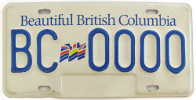 Moving licence plates from one vehicle to another is not just a simple matter of being able to use a screwdriver. Many people run into trouble when they try to move their plates to a substitute vehicle and don't do it properly.
Moving licence plates from one vehicle to another is not just a simple matter of being able to use a screwdriver. Many people run into trouble when they try to move their plates to a substitute vehicle and don't do it properly.
Of course, this could look like small change in retrospect if that person were to cause a collision before being discovered by police.

You Own Both Vehicles
The first item on the list to check is whether the replacement vehicle is already registered in your name in British Columbia. If you answer yes to this one, you must do all the paperwork and then move the licence plates to the replacement vehicle. 10 days grace does not apply.
You Are Buying a New Vehicle
Next, do you have a fully completed transfer paper (APV9T) showing that the vehicle the licence plates are coming from has been sold or otherwise disposed of? If not, you must visit your Autoplan Agent first, and then move the licence plates to the replacement vehicle.
Matching Rate Classes
Is the replacement vehicle in the same ICBC rate class as the original vehicle? The rate classes are:
- Motorcycle
- Passenger motor vehicle
- Trailer licensed under the Motor Vehicle Act
- Motor vehicle or trailer licensed under the Commercial Transport Act
If the vehicles are not in the same rate class the paperwork must be done and then the licence plates moved to the new vehicle.
Paperwork Must Be Complete
Do you have a completed and signed APV9T and registration for the replacement vehicle if it is used, or a completed and signed APV9T and bill of sale if it is a new vehicle? If not, go directly to your Autoplan Agent.
Do you have valid insurance for the vehicle being replaced, and are you carrying the insurance document with you? If not, you must visit the Autoplan Agent first yet again.
ALL Done? Move the Licence Plates
Only if you have complied with all five of the items listed above can you shift the licence plates from one vehicle to the other and operate the replacement vehicle for 10 days from the day you obtained it before having to complete the transaction at an Autoplan Agent.
The Risk of Shortcuts
Failing to follow the complete procedure exactly may put you at risk in two scenarios, police action at the roadside and legal liability.
The law considers your replacement vehicle to be unlicensed and uninsured if the transfer is not done properly. You could be liable to the fine, a tow and possibly seizure of the licence plates.
The obvious risk of legal liability is being denied insurance coverage post collision. However, that is not the only potential problem. If the new owner does not complete the transfer, you are still considered to be the registered owner and are responsible for the vehicle. Your fully completed copy of the APV9T is necessary to shift the onus onto the new owner.
Share This Article
Maybe ICBC as a monopoly could insure drivers, and not vehicles.Each vehicle would pay for an annual plate fee,and drivers would cary their own personal coverage for what ever vehicle they are going to drive,and that coverage would be based on use,vehicle class and also the drivers record.If you have multiple vehicles that only 1 person drives,you have to pay insurance on all vehicles.Good solution to a lot of issues,but it would not benifit ICBC,so no need to improve service to the customer.
- Log in to post comments
- Log in to post comments

Complicating at its finest.